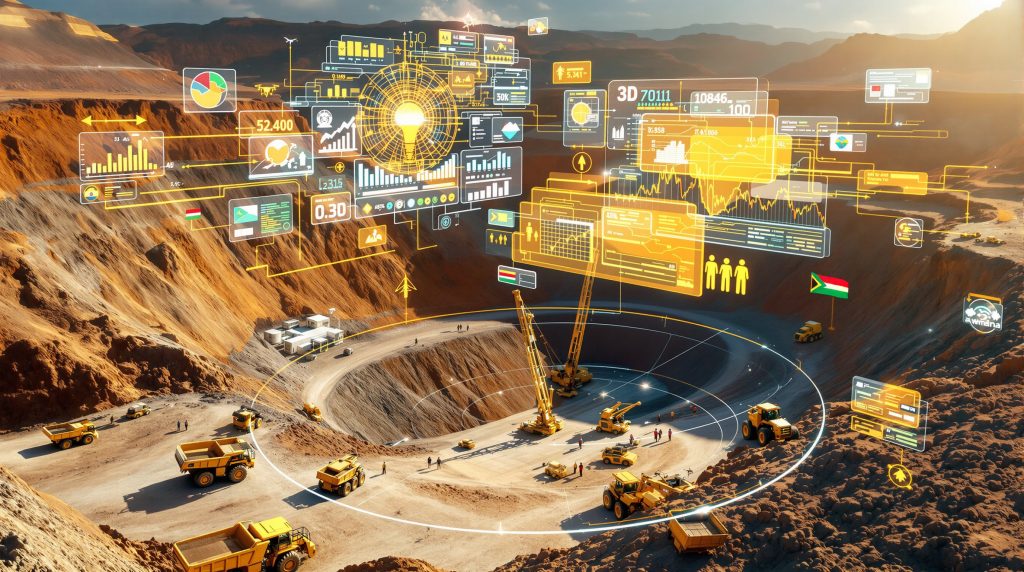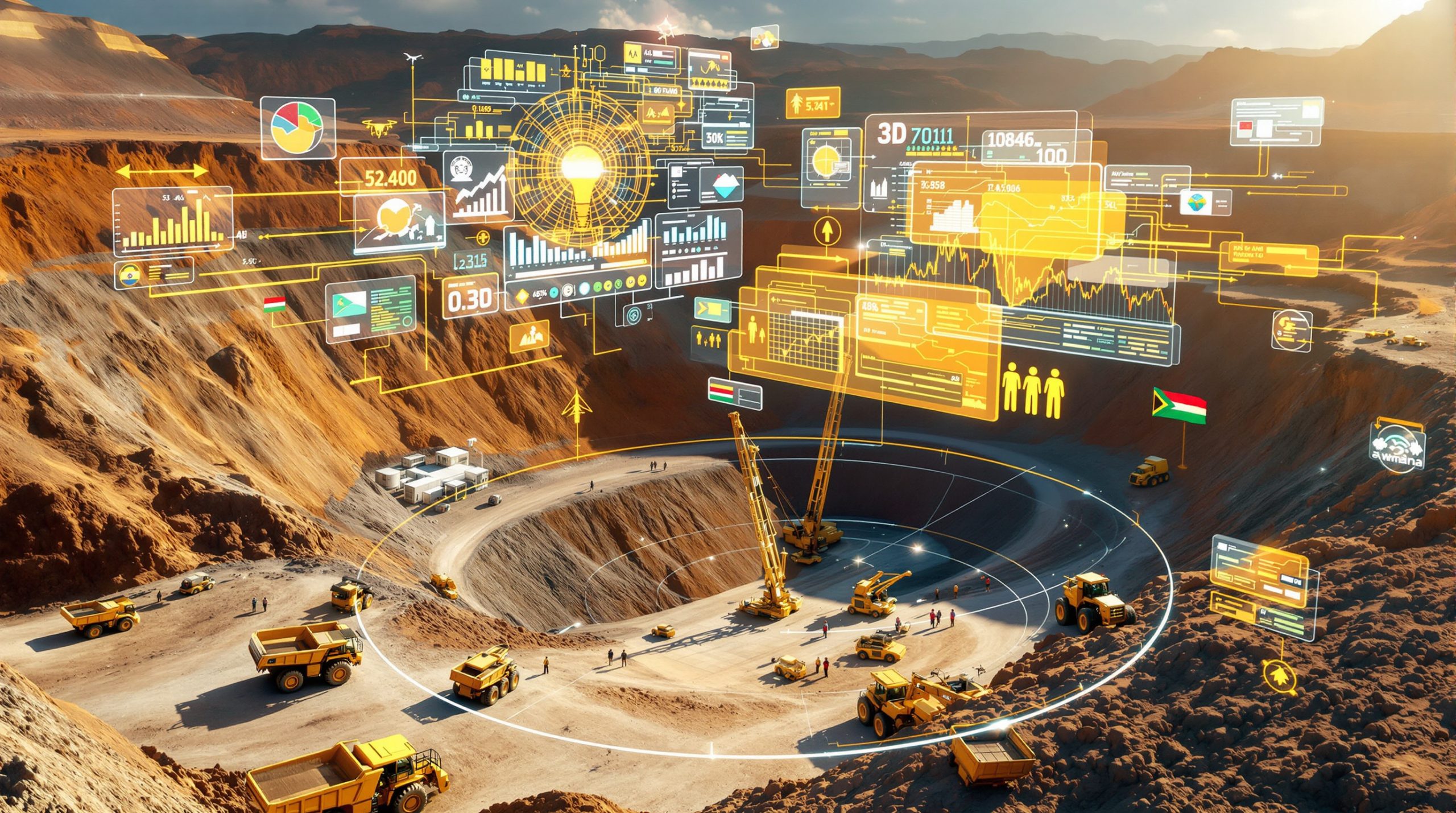Digital Transformation in Africa's Mining Sector: Innovations Driving Industry Growth
Africa's mining sector is experiencing a significant technological revolution as digital innovations transform operations across the continent. These transformations are addressing longstanding industry challenges while creating new opportunities for growth, sustainability, and economic development in a sector crucial to many African economies. As mining industry innovation continues to evolve, African operations are increasingly adopting global best practices.
The Economic Significance of Mining in Africa
Mining serves as an economic cornerstone for numerous African nations:
- Contributes 30-40% of total exports in mineral-rich countries
- Accounts for approximately 8-15% of GDP in countries like Ghana, South Africa, and Zambia
- Provides direct employment for over 500,000 people across the continent
- Supports millions more through indirect economic activity and infrastructure development
Current Challenges Facing African Mining Operations
The sector faces multiple pressing challenges:
- Volatile commodity price fluctuations creating financial uncertainty
- Increasingly complex regulatory environments requiring sophisticated compliance systems
- Growing environmental sustainability concerns from local communities and global stakeholders
- Infrastructure limitations in remote operating regions
- Persistent safety risks in traditional mining operations
- Supply chain inefficiencies and limited transparency
What Technologies Are Driving Digital Transformation in African Mining?
IoT and Sensor Technology Implementation
Internet of Things (IoT) devices and advanced sensors are revolutionizing how mining operations monitor and manage their activities:
- Real-time environmental monitoring systems track air quality, water usage, and potential contamination, reducing ecological impact and improving compliance
- Equipment health sensors detect maintenance needs before failures occur, reducing downtime by up to 25%
- Connected worker solutions monitor personnel location and health metrics, improving emergency response capabilities
- Production monitoring networks provide minute-by-minute visibility into extraction rates and quality
African mining companies implementing comprehensive IoT sensor networks report significantly improved operational visibility and reduced environmental incidents. A gold mining operation in Ghana implemented an integrated sensor network that reduced water contamination incidents by 35% while simultaneously improving production efficiency.
Automation and Robotics Advancement
Automation is transforming traditionally labor-intensive mining processes:
- Autonomous drilling systems operate continuously with minimal human intervention, improving consistency and reducing operator fatigue
- Self-driving haulage trucks transport materials more efficiently while reducing accident risks
- Robotic inspection systems access hazardous areas without endangering workers
- Automated processing facilities maintain consistent extraction rates around the clock
Mali's Syama mine represents a breakthrough case of automation implementation in Africa, achieving 30% lower operational costs through its autonomous systems while enabling near-continuous production capabilities. This implementation serves as a model for other African operations exploring automation.
Data Analytics and Artificial Intelligence Applications
Advanced analytics and AI are unlocking new value from mining operations:
| Application | Function | Measured Impact |
|---|---|---|
| Predictive maintenance | Forecasts equipment failures before they occur | 30-45% reduction in unplanned downtime |
| Resource optimization | Identifies optimal extraction patterns | 15-20% improvement in resource recovery |
| Supply chain management | Predicts logistics bottlenecks | 20-25% reduction in transportation costs |
| Market forecasting | Analyzes commodity price trends | Enhanced strategic planning capabilities |
A copper mining operation in Zambia implemented AI-powered mining efficiency systems across its haul truck fleet, reducing maintenance costs by 28% while extending average equipment lifespan by 15%. The system identifies potential failures days or weeks before they would occur, allowing for planned maintenance rather than emergency repairs.
Geospatial Technologies and Advanced Exploration
Digital tools are transforming mineral exploration approaches:
- Satellite imaging and remote sensing identify potential deposits with reduced environmental disturbance
- Drone-based surveying creates detailed 3D models of mining sites with centimeter-level accuracy
- AI-powered geological modeling improves target identification accuracy and reduces exploratory drilling
- Digital core analysis accelerates sample processing and interpretation
These technologies significantly reduce the environmental footprint of exploration activities while improving discovery rates. Mining companies in Tanzania leveraging advanced geospatial technologies report accelerated exploration timelines by 30-40% compared to traditional methods.
How Is Digital Innovation Improving Safety in African Mining?
Predictive Safety Systems
Modern digital tools are preventing accidents before they occur:
- AI-based risk prediction identifies potential safety hazards using historical data and environmental monitoring
- Environmental monitoring systems detect dangerous gas levels and structural weaknesses in real-time
- Wearable technology tracks worker vital signs and location, ensuring timely emergency intervention
- Digital training simulations prepare workers for emergency scenarios without exposure to real danger
These systems collectively contribute to significant safety improvements. Digital safety implementations across several African operations have contributed to a 30-35% reduction in mining-related injuries, with particular success in preventing serious accidents.
Remote Operations and Reduced Human Exposure
Technology is removing workers from the most dangerous mining environments:
- Remote control centers allow operators to manage equipment from safe locations kilometers away
- Tele-remote systems enable precision work in hazardous areas without physical presence
- Autonomous vehicles reduce driver exposure to dangerous conditions including dust, vibration, and collision risks
- Drone inspection capabilities allow visual assessment of unstable areas without human entry
A platinum mining operation in South Africa now conducts approximately 60% of its potentially hazardous operations via remote systems, significantly reducing worker exposure while maintaining production targets. Similar implementations are spreading across the continent as technology costs decrease.
Enhanced Emergency Response Capabilities
Digital tools improve crisis management:
- Real-time location tracking pinpoints worker positions during emergencies with meter-level accuracy
- Integrated communication systems ensure rapid response coordination across complex mining operations
- Digital evacuation management identifies optimal escape routes based on emergency conditions
- Automated emergency systems can independently initiate safety protocols when dangerous conditions are detected
Mining operations equipped with integrated emergency response technologies report 35-40% improvements in response times during simulated emergency scenarios, potentially saving lives during actual emergencies.
What Environmental Benefits Does Digital Transformation Bring?
Resource Optimization and Waste Reduction
Digital technologies enable more precise resource management:
- Advanced analytics optimize extraction to minimize unnecessary material removal
- Precision drilling technologies reduce overburden and waste by 20-30%
- Real-time grade control ensures only valuable material is processed, reducing energy consumption
- Digital mine planning identifies extraction sequences that minimize environmental impact
These capabilities translate to measurable environmental benefits. Digitally-optimized operations consistently report 25-40% reductions in waste material production compared to traditional methods, significantly reducing their environmental footprint.
Water Management Innovations
Water conservation technologies address critical sustainability concerns:
- Smart water monitoring systems track usage and detect leaks in real-time across operations
- Automated recycling facilities increase water reuse by up to 70-80% in processing operations
- Predictive contamination prevention identifies potential issues before they affect local water sources
- Digital watershed management models regional water impacts for more sustainable planning
A gold mining operation in Ghana implemented an integrated digital water management system that reduced freshwater consumption by 40% while simultaneously improving mineral recovery rates. Similar systems are being deployed across drought-prone regions of Africa.
Energy Efficiency Improvements
Digital tools are reducing the carbon footprint of mining operations:
- Smart grid technologies optimize energy distribution across mining sites
- Load management systems reduce peak power demands by 25-30%
- Renewable energy integration platforms balance traditional and alternative energy sources
- Energy usage analytics identify optimization opportunities across operations
Mining operations implementing comprehensive energy management systems report 20-35% energy savings compared to traditional operations, with corresponding reductions in carbon emissions and operating costs. These advancements align with broader mining electrification trends reshaping the industry globally.
How Does Digital Innovation Drive Operational Efficiency?
Supply Chain Optimization
Digital technologies are streamlining the mining value chain:
- Blockchain-based tracking ensures transparency from extraction to market
- Predictive inventory management reduces stockouts and overstock situations
- Automated procurement systems optimize purchasing decisions based on operational needs
- Logistics optimization reduces transportation costs and delivery times
Leading African mining operations implementing digital supply chain solutions report 15-20% reductions in overall logistics costs while improving on-time delivery performance by 25-30%.
Maintenance Revolution Through Predictive Analytics
Data-driven maintenance is transforming equipment management:
- Condition-based monitoring identifies maintenance needs based on actual equipment state rather than fixed schedules
- Failure prediction algorithms forecast potential breakdowns weeks in advance
- Digital twins simulate equipment performance under various conditions to optimize maintenance timing
- Maintenance workflow automation ensures efficient execution of required service activities
Mining operations implementing predictive maintenance programs report 20-30% extended equipment lifespan while reducing overall maintenance costs by 20-25% through the elimination of unnecessary service activities and prevention of catastrophic failures.
Workforce Productivity Enhancement
Digital tools are empowering mining professionals:
- Mobile work management platforms provide real-time task assignment and tracking
- Augmented reality training accelerates skill development without operational disruption
- Performance analytics identify opportunities for process improvement
- Digital knowledge management preserves critical expertise and improves knowledge transfer
Mining companies equipping their workforce with digital tools report 25-35% productivity improvements as workers spend less time on administrative tasks and more time on value-adding activities.
What Challenges Must Be Overcome for Successful Digital Transformation?
Infrastructure and Connectivity Limitations
Physical constraints present significant hurdles:
- Limited reliable power in remote mining regions challenges technology deployment
- Insufficient telecommunications infrastructure for data-intensive applications
- Transportation challenges for equipment delivery and maintenance
- Harsh environmental conditions that can damage sensitive digital equipment
Forward-thinking mining operations are addressing these challenges through satellite-based connectivity solutions and renewable energy microgrids that provide reliable power for digital systems even in remote locations.
Skills Gap and Workforce Development
Human capital remains a critical challenge:
- Shortage of digital skills among existing mining workforce
- Limited training infrastructure in many mining regions
- Cultural resistance to technological change
- Competition for technology talent with other industries
Public-private partnerships are establishing specialized digital mining academies in countries like South Africa and Ghana to address these skills gaps, with early programs showing promising results in developing local technological expertise.
Regulatory Framework Adaptation
Policy environments must evolve alongside technology:
- Outdated mining regulations that don't address digital innovations
- Data sovereignty concerns regarding information storage and processing
- Cybersecurity governance requirements for critical infrastructure
- Balancing innovation with protection of local employment
Several African nations have established dedicated mining technology regulatory task forces to modernize legal frameworks while protecting national interests, though progress varies significantly by country.
How Are African Mining Companies Implementing Digital Strategies?
Phased Implementation Approaches
Successful transformations follow strategic deployment patterns:
- Pilot projects test technologies in controlled environments before wider deployment
- Scalable solutions expand based on demonstrated success metrics
- Integration frameworks ensure new systems work with existing infrastructure
- Clear ROI measurement guides investment decisions
A major Botswanan mining operation achieved full digital transformation through a carefully structured 3-year phased implementation plan that prioritized quick-win technologies before moving to more complex systems.
Collaborative Innovation Ecosystems
Partnership models accelerate digital adoption:
- Technology vendor alliances provide specialized expertise and implementation support
- Academic research partnerships develop region-specific solutions
- Cross-industry collaborations share best practices and resources
- Startup incubation programs nurture local technology innovation
The African Mining Innovation Consortium has grown to connect 15 major mining companies with technology providers and universities, creating a powerful ecosystem for shared learning and technology development.
Return on Investment Measurement
Financial discipline guides digital investments:
- Comprehensive cost-benefit analysis for all digital initiatives
- Staged funding models tied to performance milestones
- Total value of ownership calculations beyond initial implementation
- Multi-factor ROI frameworks that include safety and sustainability benefits
Leading digital mining projects in Africa demonstrate ROI timeframes of 12-24 months for most implementations, with the most successful programs achieving payback periods of less than one year for targeted technologies.
What Does the Future Hold for Digital Mining in Africa?
Emerging Technology Frontiers
Next-generation innovations are on the horizon:
- Quantum computing applications for complex geological modeling
- Advanced robotics for ultra-deep mining operations
- Biotechnology integration for environmentally-friendly mineral processing
- Autonomous drone swarms for comprehensive site monitoring
Industry experts project that by 2030, fully autonomous mining operations will be operational in at least five African countries, with these technologies spreading more widely as costs decrease and capabilities improve. According to Brookings Institution research, digital innovation in Africa's mining industry could increase productivity by up to 40% while significantly reducing environmental impacts.
Sustainability and ESG Integration
Digital tools will increasingly support environmental and social governance:
- Community impact monitoring platforms provide transparency to local stakeholders
- Carbon footprint tracking systems support emissions reduction goals
- Social license management tools strengthen relationships with host communities
- Circular economy technologies minimize waste and maximize resource utilization
Mining operations implementing comprehensive digital ESG platforms report improved relationships with local communities and greater success in obtaining operating permits for expansion projects.
Economic Transformation Opportunities
Digital mining creates broader economic benefits:
- Local technology ecosystem development around mining innovation
- Skills transfer to other sectors of African economies
- Infrastructure improvements that benefit broader communities
- New business model opportunities for service providers and entrepreneurs
Economic analyses suggest that digital mining technologies could add $25-30 billion to African GDP by 2030 through direct improvements in mining productivity and broader economic spillover effects.
What Steps Should Mining Companies Take to Embrace Digital Innovation?
Strategic Digital Roadmap Development
Successful transformation requires clear planning:
- Conduct comprehensive digital readiness assessment
- Identify high-impact opportunity areas based on specific operational challenges
- Develop phased implementation strategy with clear milestones
- Establish clear metrics for success and ROI measurement
- Create governance structures for digital initiatives
Mining companies that develop comprehensive modern mine planning approaches before beginning implementation report significantly higher success rates and faster time to value compared to those pursuing opportunistic technology adoption.
Technology Partner Selection Criteria
Choosing the right collaborators is critical:
- African market experience and understanding of local contexts
- Scalability capabilities to grow with operational needs
- Integration expertise with legacy mining systems
- Support infrastructure for ongoing maintenance and updates
Mining companies report that partner selection is one of the most critical success factors in digital transformation, with local knowledge and long-term support capabilities often outweighing pure technological capabilities.
Change Management and Cultural Transformation
Human factors determine digital success:
- Executive leadership commitment to digital transformation
- Workforce engagement throughout the implementation process
- Skills development programs that prepare employees for new roles
- Communication strategies that clearly articulate the benefits of change
Mining operations that invest 20-30% of their digital transformation budgets in change management and training report significantly higher adoption rates and faster realization of benefits.
How Can African Governments Support Mining Digitalization?
Policy Framework Modernization
Regulatory environments must enable innovation:
- Updated mining codes that recognize digital technologies
- Data governance frameworks that protect sovereignty while enabling innovation
- Digital infrastructure investment incentives for remote regions
- Technology import policies that facilitate equipment acquisition
Rwanda and Ghana have established dedicated mining technology regulatory frameworks that are emerging as regional models, encouraging digital adoption while protecting national interests.
Education and Skills Development Initiatives
Human capital development requires government support:
- STEM education enhancement in mining regions
- Technical certification programs for digital mining skills
- University partnerships for advanced mining technology research
- Entrepreneurship support for local technology providers
Countries with national mining skills programs consistently show 30-40% faster digital adoption rates compared to those without coordinated human capital development strategies. As the African Mining Market reports, educational initiatives are crucial for ensuring local populations benefit from digital innovation in Africa's mining industry.
Public-Private Partnership Models
Collaborative approaches accelerate progress:
- Innovation hubs focused on mining technology
- Shared infrastructure investments for connectivity and power
- Joint research initiatives addressing region-specific challenges
- Startup funding mechanisms for local technology development
The South African Mining Digitalization Partnership connects government agencies, mining companies, and technology providers in a collaborative model that has accelerated technology deployment while ensuring benefits are widely distributed.
FAQ: Digital Innovation in African Mining
What immediate benefits can mining companies expect from digital transformation?
Digital transformation typically delivers rapid improvements in several areas:
- 15-30% reduction in operational costs through efficiency gains
- 20-40% improvement in equipment utilization through predictive maintenance
- 25-35% enhancement in worker safety metrics
- 30-50% acceleration in decision-making processes through real-time data access
These benefits generally begin to materialize within 3-6 months of implementation for targeted solutions, though comprehensive transformation takes longer to fully realize.
How can smaller mining operations approach digitalization with limited budgets?
Smaller operations can implement digital solutions through:
- Prioritizing high-impact, low-cost technologies first
- Exploring Software-as-a-Service (SaaS) models with lower upfront costs
- Joining industry consortiums to share technology development costs
- Focusing on modular solutions that can scale over time
The most successful small-scale implementations start with specific operational pain points rather than attempting comprehensive transformation.
What cybersecurity considerations are essential for digitalized mining operations?
Critical security measures include:
- Isolated operational technology networks
- Regular security assessments and penetration testing
- Comprehensive employee security awareness training
- Incident response planning specific to mining operations
- Vendor security evaluation for all digital partners
As mining operations become more connected, cybersecurity must be integrated into all aspects of digital strategy rather than treated as a separate concern. Advanced technologies like AI in drilling and blasting create particular security considerations that must be addressed through comprehensive security frameworks.
How is blockchain technology specifically being applied in African mining?
Blockchain applications in African mining include:
- Mineral provenance tracking for conflict-free certification
- Supply chain transparency from mine to market
- Automated contract execution through smart contracts
- Community benefit distribution tracking
- Regulatory compliance documentation
These applications are particularly valuable in regions where trust and transparency have historically been challenging, helping mining companies demonstrate responsible practices to global markets.
Further Exploration:
Readers interested in learning more about digital innovation in Africa's mining industry can explore additional educational content from industry associations and publications, which offer diverse perspectives on technological advancements in the global mining sector.
Ready to Capitalise on the Next Major Mineral Discovery?
Stay ahead of the market with Discovery Alert's proprietary Discovery IQ model, which instantly notifies investors of significant ASX mineral discoveries across Africa and beyond, turning complex data into actionable insights. Begin your 30-day free trial today at Discovery Alert to position yourself for potential substantial returns from tomorrow's mineral discoveries.




